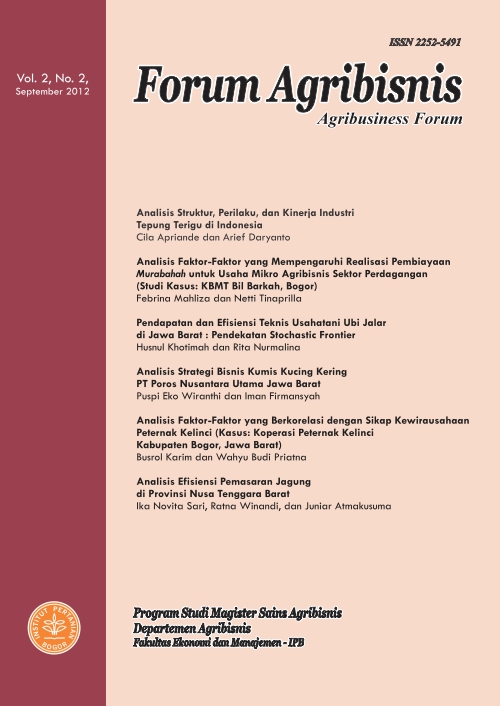ANALISIS EFISIENSI PEMASARAN JAGUNG DI PROVINSI NUSA TENGGARA BARAT
Main Article Content
Abstract
Maize is one of important agricultural commodity which can be used for food and feed. However, the marketing of this commodity still inefisient. The purpose of this research is to analyze marketing efficiency of maize of West Nusa Tenggara Province via marketing channel, market structure, market behavior, market performance and marketing strategy. Sampling was conducted by simple random sampling and the number of sample used is 30 people. The method used is SCP analysis that consists of margin, price-share, market integration and marketing mix. The result shows marketing inefficiency presence, where 48.66 percent of farmers use second channel, to sell directly to wholesalers. Market structure tendency is oligopsony, where the wholesalers influence price. The margin distribution among the three channels are differs. Vertical market integration is strong in the short and long run, but only on wholesaler level. Marketing strategy on wholesaler level could not increase marketing efficiency due to the homogenous nature of product sold, dry shelled corn. The price is determined by quality and production cost. Promotion done via words of mouth and most sellers choose to sell along the main road although fifty percent of them live in the countryside.
Downloads
Download data is not yet available.
Article Details
How to Cite
SariI. N., WinandiR., & AtmakusumaJ. (2012). ANALISIS EFISIENSI PEMASARAN JAGUNG DI PROVINSI NUSA TENGGARA BARAT. Forum Agribisnis : Agribusiness Forum, 2(2), 191-210. https://doi.org/10.29244/fagb.2.2.191-210
Section
Articles
The author submitting the manuscript must understand and agree that the copyright of the article manuscript must be submitted/transferred to the Journal Forum Agribisnis. This work is licensed under the Creative Commons Attribution-ShareAlike 4.0 (CC BY-SA) International License in which the Author and Reader can copy and redistribute the material in any media or format, and remix, modify and build material for any purpose, but they must provide appropriate credit (citing articles or content), provide a link to the license, and indicate whether there is a change. If you mix, change, or create material, you must distribute your contribution under the same license as the original.

